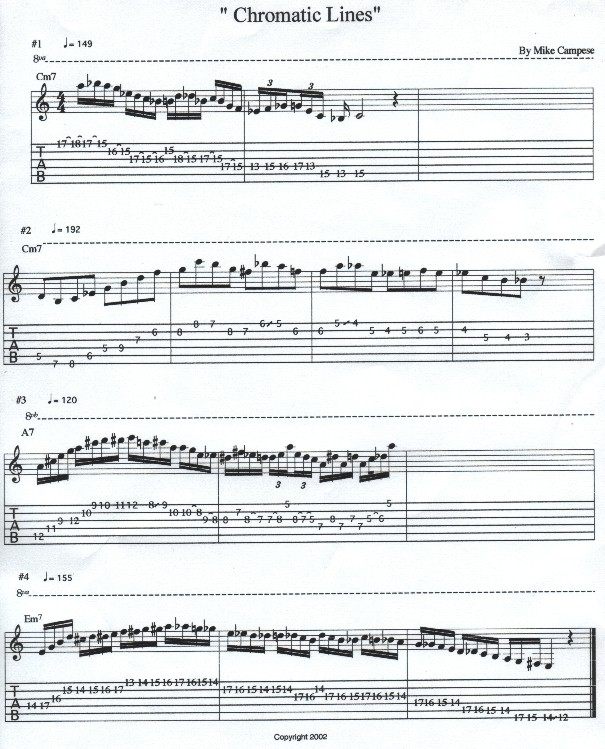Hello! Happy international Guitar month. Thanks for checking out the lessons; I hope you learned a lot so far. In this column we are going to talk about adding Chromatics to your lines .If you don't know what chromatic means, it means tones that add color, moving in halfsteps. For example: C, C#, D, D#, E, F, etc. You can add these passing tones to the scales you are using. You can approach any chord tone a half step above or below. Or, you can target the note a whole step above the chord tone. When using this concept, the object is to resolve on a scale or chord tone. We are going to introduce this with a few lines i wrote for you. Here goes...
Example 1 - Here is a legato line using the C Dorian scale (C, D, Eb, F, G, A, Bb). If you notice on beat 3 in the first bar, I added the B and the Db to the scale. Also, in the second bar I added an extra note in the middle of the F and G.(F, F#, G).The F# is the passing (or chromatic) tone. Again, don't forget to resolve on a scale or chord tone - if not, your lines will sound weird.
MP3 - Example 1
Example 2 - This is a jazzy line that is based off the C Melodic minor scale (C, D, Eb, F, G, A, B). You will see in bar 2 there is a 4 note phrase descending in half steps. In bars 3 and 4 we have more added passing tones. We resolve on a Bb, which is the flat 7th of C. Play this line over a Cm7 chord, so you can hear how it relates.
MP3 - Example 2
Example 3 - Here's a bluesy line for you. We start off using an A7 arpeggio.(A, C#, E, G). Then we fill between the chord tones C# and E with the passing tones D and D#. The rest of the line is just the A Blues scale (A, C, D, Eb, E, G), except the Major 3rd note, C#. Play this lick over an A Blues rhythm.
MP3 - Example 3
Example 4 - Our last line is based off of E minor. In bar 1, we have a Em7 arpeggio (E, G, B, D). On beat 2, I added a lot of chromatic passing tones, filling in between the scale and chord tones. A basic rule is: any chord tone can be approached by four ascending or four descending halfsteps. In bar 2, there is a 4 note sequence descending down the chromatic scale. In bar 3, we wind down the line with more passing notes, finally resolving to the root note, E.
MP3 - Example 4

OK, that wraps up our lesson. Make sure you use these simple concepts to make up your own lines. You will begin to see that every note works, as long as you resolve on a chord tone. If you have any questions feel free to email me. Also check out my CDs "Full Circle" and "Total Freedom", and for more information visit www.mikecampese.com. Good luck!
Mike Campese is an all-around music performer, session artist and teacher competent in many musical styles, electric and acoustic. He has studied at G.I.T. (Honors Graduate), and with Paul Gilbert, Norman Brown, Stanley Jordan, Scott Henderson and Keith Wyatt.